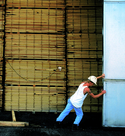Original work
5 September 2009AHEC grading consultant Bob Sabistina explains some of the US hardwood grading issues that originate at the sawmill
Summary
• US hardwood grading inspectors grade a minimum of 12,000 board feet per day.
• A 2in red oak board could take up to a year to dry to 6-9% moisture content.
• The lumber is graded again after drying.
• There are six defect limitations that will disqualify a board from the FAS grade.
Question: Please describe the procedures taken in the American sawmill to produce my container of FAS red oak lumber.
Answer: All lumber must be graded and sorted when it is freshly sawn. This means that an inspector must look at everything that is coming out of the sawmill. This production includes any or all of the following: all of the Standard Grades from FAS to No 3 Common, which would be used for furniture, flooring, or any traditional application for hardwood lumber; boards below No 3 Common that can only be used for pallets or crates; various thicknesses in each grade; special sorts for special orders; timbers or cants for industrial type uses; mis-cuts and lumber mis-milled etc. An inspector is asked to grade a minimum of 12,000 board feet per day. The FAS grade is probably not more than 20% of the total production of an average run of logs.
After the inspector grades a piece of lumber, he puts a mark on the board to let the people down the chain know which package to put the board in. The lumber is not only sorted by grade but by length, thickness, and sometimes by colour and width, depending on the species and upcoming order file. These upcoming orders will also determine if the lumber will be placed on drying sticks for kiln drying or simply flat piled to be shipped green. If the lumber is to be shipped green, the packages are banded with strapping and put on a truck as soon as possible and shipped out.
Q: Can you expound on the kiln drying process?
A: FAS lumber that is to be dried at the mill has been put on kiln-dried sticks and must begin the slow process of drying. The sticks must be dried and of uniform thickness and most are moulded into a detail that reduces contact between the stick and the board. These must be placed uniformly one on top of the other and supported by crosspieces from one package to another. Improper sticker alignment will lead to warped and twisted lumber. Depending on a number of factors, most importantly species and thickness, the lumber is put in air-drying sheds or directly in the dry kiln. A 4/4 or 1in-thick red oak board will take approximately three to four months to be properly dried. An 8/4 or 2in red oak board could easily take up to a year to dry to the desired moisture content of between 6-9%. Any shortcuts in the drying process can result in a number of undesirable outcomes.
Q: Once the lumber has gone through the drying process, is it ready?
A: Almost. The lumber needs to be taken off the sticks and graded again. This dry inspection will ensure that no boards have degraded in the drying process. The inspector might have to trim off a bad end or edge a board to ensure that you receive the FAS grade you are paying for. The lumber is then sorted for length, flat piled and banded with steel strapping. At this time most companies will have a tally man to end tally the lumber, taking into account the widths and lengths. This tally can then be converted in board feet, cubic metres, or whatever form of measurement agreed to in the sales contract.
Q: Is there a limit to the number of splits I receive on my FAS lumber?
A: There are six defect limitations that will disqualify a board from the FAS grade. These defects must be considered first by the inspector when the lumber is freshly cut. Usually, they are trimmed or edged off when the lumber is green, ensuring that the FAS grade is maintained throughout the drying process.
Splits are limited in length to twice the surface measure (SM) or one lineal foot of standard length, whichever is greater. For example, a board that is 6in wide x 8ft long has a 4ft SM. The maximum length of split allowed would be 12in or 1ft (see diagram). A board 8in wide x 12ft long has an 8ft SM and the longest split cannot exceed 16in. The rule of thumb when grading fresh sawn lumber is to trim back any splits in excess of one foot. The idea here is that, during the drying process, the likelihood of the split increasing is greater and its removal will help out on the dry inspection. On your dry lumber though, the rule stands as described above. Remember, the board must still yield FAS outside of the split area so it will not affect the clear area you are paying for.

